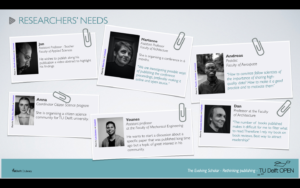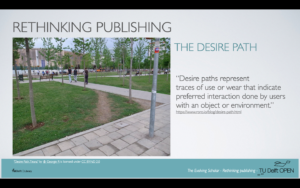There is so much happening in scholarly communications!
We know about the raised problems of researchers in the publishing landscape, about the lack of transparency and visibility or the gaps in recognition of their work, like peer-reviewing, within the research assessment. On the other side, cOAlitionS announced their intentions of returning the public money to the public in the form of OA papers. It’s understandable then that one can find so many new publishing environments, channels or new approaches to publishing. It’s not trivial to start any one of them but this is what we did: we started our own single-article mega-journal.
Figure 1. Presentation given at LIBER 2021, Session #11:
Rocky Road: Opportunities & Challenges in Open Publishing.
Zenodo. https://doi.org/10.5281/zenodo.5061080
The Evolving Scholar
The single-article journal is part of our own publishing platform, TU Delft OPEN, a young publisher, launched in 2019. It was a response to the increased activity within the academic community of creating open access journals. Now we have three lines of development: besides Open Access Journals, also Open Access Books and Open Access Textbooks.
Noteworthy, the editorial work for all journals is in the hands of the researchers. But, while all the discipline-oriented journals are initiated by the faculties (from TU Delft or other universities), The Evolving Scholar was initiated by us. With its creation, we tried to address and solve some of the problems in scholarly publishing.
What was that we wanted?
A solution that embraces, besides open access single article publishing, new forms of publications, an open peer-review publishing process, and a community-driven platform, with the authors, the reviewers, and the moderators in lead. That is how we partnered with a start-up from CERN, Orvium, who developed a platform with the same goals as ours and therefore, could support our design and requirements.
With an infrastructure in place, if the researchers would have wanted to publish open access, we were ready. Of course, that alone was no guarantee for success. This is how we got to the point of rethinking our approach to scholarly publishing.
We tried to consider the whole ecosystem and our position within and we decided that we have no intention of competing with another publisher, we are there for researchers who need a tailored solution to their publishing needs.
With this in mind, we needed to identify some core needs of change in publishing that we can act on and this is what we found:
- there is a sensible amount of invisible work during the research lifecycle itself therefore unaccounted for and, with no recognition and
- there are researchers unhappy with the lack of control in the publishing process of their work
We made it our mission to:
- become a publishing companion during the whole research lifecycle – so we can unravel the hidden work by listening to researchers and work together towards a sustainable solution
- give them the control of the publishing process and of the control on the content quality through the open peer-review
- bring in new (technological) developments and let people try – the one calculated risk we want to take: make this platform an experimental, collaborative space and let it grow, evolve.
That translates into
- building a good foundation – the platform – with solid requirements,
- opening up to multiple content types and let the community, the researchers share their research in a form of convenience,
- leaving the editorial work and control of the publishing process in the hands of the researchers
- develop together (workflows, collections, templates, eventually taxonomies) and
- facilitate the process of open peer-review in a convenient way for the researchers, with the promise of transparency
We have some examples of publishing needs that deserved our full consideration (Figure 2): see fictive researchers (and staff) with real stories.

- (Preprint + Peer-reviewed) conference papers
Researchers need fast a solution to their coming conference. First, they need to publish their conference papers as preprint – to give them the flexibility to put manuscripts online at submission. After the submission of the full paper, the organizers would have only one month to review the papers till the conference, which is impossible. That means that they will take care of the review process after the conference. The editorial work is entirely under their control. This is an event-related publishing model with a temporary community.
- Datasets peer-review
4TUResearch.Data – the data repository for four universities in The Netherlands – takes care of storing and preserving datasets and ensures they are Findable Accessible, Interoperable, and Reusable (FAIR data). What about the quality of the data? We intend to introduce datasets reviews and with it a stamp of data quality.
- Topic collections
In our library, we started a citizen science development project within our university’s open science strategical program. One wish of the citizen science team and its coordinator is to create one publishing channel for citizen scientists – whether researchers, students or citizens. The Evolving Scholar – Focus on Citizen Science could be an example of such a community.
Some other needs are related to book reviews – an added quality mark to books published by TU Delft OPEN or other publishers, video abstracts for scientific papers – most of them already launched on YouTube and conversations – opinion pieces on articles published elsewhere that matter to a group of interested people.
All these publication types are not all new but what is new, is our approach.
There is a term used in Design Thinking, “the desire path”, which is meant to give an example of how people move from point A to point B in contrast to what others may think – the designed path – we should move from point A to point B (Figure 3).

Our vision for The Evolving Scholar is no designed path yet, but design and create the foundation: think of the platform as a full green grass field. “Rethinking publishing” it’s about creating the environment and applying the desire path principle: let the researchers walk, accompany them while making their own pathways in publishing, build together and then, put the tiles.
This is what we mean by tailored solutions. They can be different for different groups of researchers, from infrastructure till publishing, the roles and activities distribution will be different. Every path is approached with a design thinking framework in mind.
There are, of course, challenges to meet in every direction we move:
- the novel types of publications: we are open to the publication of negative results, of orphan studies, as well and we try to accommodate interactive publications. This will require time, a good strategy, and good technical support.
- the open peer-review: there is a lot of literature about the value and the pitfalls of open peer review. We embrace open peer review but obviously, not everyone does! We allow reviewers’ discussions with the authors behind doors but we publish the reviews after the completion of the review process.
- the community-driven reality-check: how do you ensure healthy interactions for the sake of high-quality content? We decided to bring in, along with the moderators, a minimal editorial team: it helps us first with acceptance from the indexing bodies, like DOAJ, and consequently, the researchers. The editors will be the first scope and content filter within an expert community. From there on, the interaction will be in the control of the community itself. We decided to dismiss any negative reputation to regulate the interactions so the editors/moderators will intervene only in case of conflicts.
Take into account that, with the exception of the publishing avant-garde, most of the researchers are enthusiasts when talking about the concept of open science; but when publishing open access and open peer-review, there are some barriers to cross, like the power of the h-index and impact factor or the established audience channels, both very valid obstacles.
Last but not least: we have some lessons learned!
- Be agile!
Making plans too much in advance doesn’t really work. Researchers are very fast! And - Be present!
Talk to them informally, there are a lot of hidden problems. Bottlenecks can be solved by just having a chat.
What next?
We have plans but more importantly, we want to put some bricks to the foundation of open science for a free flow of knowledge. Do you need to publish your work open access and open to peer-review? Join The Evolving Scholar, we’re there for you!
Acknowledgments
This content is the result of the work done together with TU Delft Publishing Officer, Frédérique Belliard (F.Belliard@tudelft.nl).
Reference
- Rademakers, Jo, Köster, Massimo, Bracco, Laetitia, Nastase, Nicoleta, & Belliard, Frédérique. (2021, July). LIBER 2021 Session #11: Rocky Road: Opportunities & Challenges in Open Publishing. Zenodo. http://doi.org/10.5281/zenodo.5061080
Notes and considerations on the presentation given at the LIBER 2021 conference
Written by Nicoleta Nastase (n.nastase@tudelft.nl)

